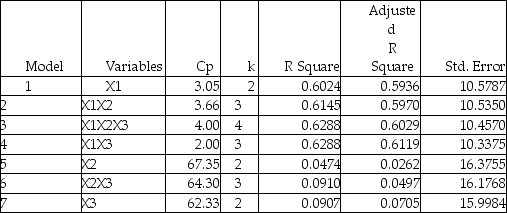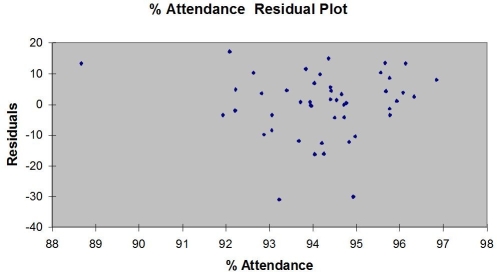True/False
TABLE 15-4
The superintendent of a school district wanted to predict the percentage of students passing a sixth-grade proficiency test.She obtained the data on percentage of students passing the proficiency test (% Passing),daily mean of the percentage of students attending class (% Attendance),mean teacher salary in dollars (Salaries),and instructional spending per pupil in dollars (Spending)of 47 schools in the state.
Let Y = % Passing as the dependent variable,X1 = % Attendance,X2 = Salaries and X3 = Spending.
The coefficient of multiple determination (  )of each of the 3 predictors with all the other remaining predictors are,respectively,0.0338,0.4669,and 0.4743.
)of each of the 3 predictors with all the other remaining predictors are,respectively,0.0338,0.4669,and 0.4743.
The output from the best-subset regressions is given below:  Following is the residual plot for % Attendance:
Following is the residual plot for % Attendance:  Following is the output of several multiple regression models:
Following is the output of several multiple regression models:
Model (I):  Model (II):
Model (II):  Model (III):
Model (III): 
-True or False: Referring to Table 15-4,the null hypothesis should be rejected when testing whether the quadratic effect of daily average of the percentage of students attending class on percentage of students passing the proficiency test is significant at a 5% level of significance.
Correct Answer:

Verified
Correct Answer:
Verified
Q12: True or False: Collinearity is present if
Q19: Which of the following will not change
Q25: The _ (larger/smaller)the value of the Variance
Q39: TABLE 15-6<br>Given below are results from the
Q41: An independent variable X<sub>j</sub> is considered highly
Q44: TABLE 15-6<br>Given below are results from the
Q45: TABLE 15-6<br>Given below are results from the
Q46: TABLE 15-6<br>Given below are results from the
Q48: True or False: Referring to Table 15-3,suppose
Q54: A microeconomist wants to determine how corporate